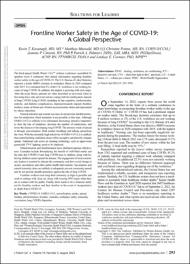Frontline Worker Safety in the Age of COVID-19: A Global Perspective

Ver/
Descargar
(application/pdf: 177.0Kb)
(application/pdf: 177.0Kb)
Fecha
2023-05-10Autor(es)
Kavanagh, Kevin T
Matthias Maiwald, Christine Pontus
Cimiotti, Jeannie P
Palmieri , Patrick A
Cormier, Lindsay E
Metadatos
Mostrar el registro completo del ítemResumen
The third annual Health Watch USA sm webinar conference assembled 16 speakers from 4 continents who shared information regarding frontline worker safety in the age of COVID-19. The U.S. Bureau of Labor Statistics reported a nearly 4000% increase in workplace illness in 2020 compared with 2019. It is estimated that 2% of the U.S. workforce is not working because of long COVID. In addition, the impact is growing with each surge. After the acute illness, patients are often described as recovered, when in fact many have only survived and are coping with the multisystem impacts of long COVID. Long COVID, including its late cognitive, cardiovascular, embolic, and diabetic complications, disproportionately impacts frontline workers, many of whom are of lower socioeconomic status and represented by ethnic minorities. Natural infection and current vaccines do not provide durable protection for reinfection. Herd immunity is not possible at this time. Although SARS-CoV-2 is unlikely to be eliminated, decreasing spread is imperative to slow the rate of mutations, decrease the number of reinfections, and lower the chances of developing long COVID. The primary mode of spread is through aerosolization. Both routine breathing and talking aerosolizes the virus. With the extremely high infectivity of SARS-CoV-2, it is unlikely that central building ventilation alone will be enough to satisfactorily mitigate spread. Additional safe active air cleaning technology, such as upper-room germicidal UV-C lighting, needs to be deployed. Misinformation and disinformation have inhibited response effectiveness. Examples include downplaying the benefit of well-fitted masks and the risks that COVID-19 and long COVID pose to children, along with believing children cannot spread the disease. The engagement of local community leaders is essential to educate the community and drive social change to accept vaccinations and other public health interventions. Vaccinations and natural immunity alone are unlikely to adequately prevent community spread and do not provide durable protection against the risk of long COVID. Frontline workers must keep their immunity as high as possible and work in settings with clean air, along with wearing N95 masks when they are in contact with the public. Finally, there needs to be a financial safety net for frontline workers and their families in the event of incapacitation or death from COVID-19.
Palabras clave
Colecciones
- Web of Science (WOS) [236]

